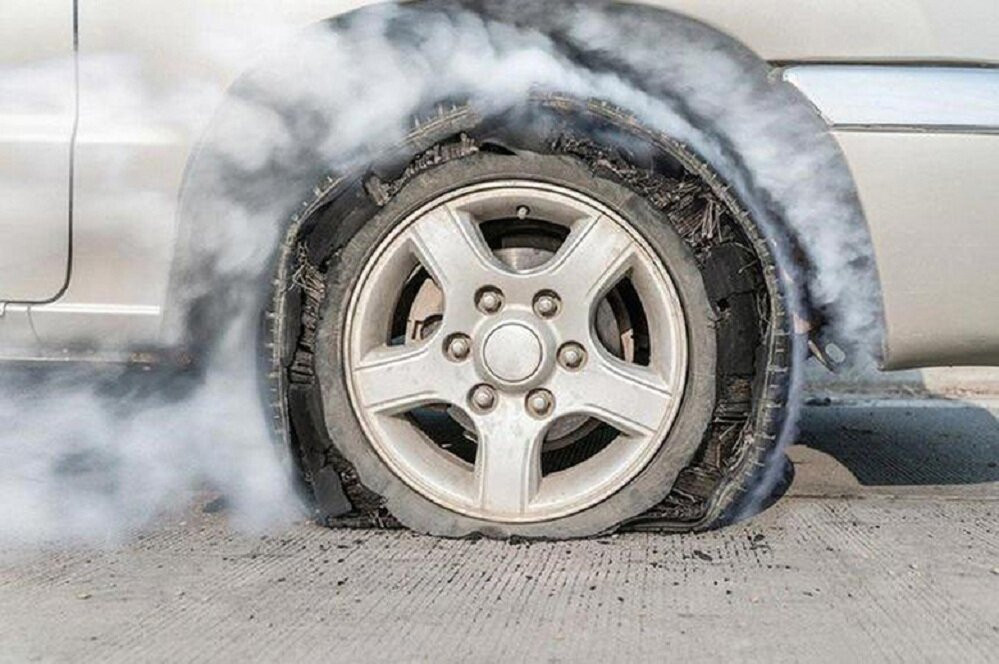A tire explosion while the car is moving is a potentially unsafe situation, so how to handle it to ensure safety?

A tire blowout while the car is moving is a potentially dangerous situation.
Causes of tire explosion
Under-inflated or over-inflated tires
Under-inflation causes the tire to be under more pressure than normal. At the same time, the tire surface in contact with the road too much also makes the tire susceptible to heat, causing it to explode. On the contrary, over-inflation, which is subjected to high pressure from the inside, when squeezed hard or suddenly impacted, also has the risk of exploding.
Stabbed by a sharp object
This is also one of the reasons why car tires explode. Sharp objects such as nails, stones, pieces of iron... can puncture tires, potentially causing an explosion when the car is running at high speed.
Tires are too old
If the tire is too old, it will wear to the limit and when operating at high speed, the factors of temperature, pressure and load capacity will completely destroy your tire. When the driver runs on the highway at high speed, the tire friction with the road surface and heat leads to sudden tire explosion, especially old tires with limited endurance.
According to manufacturers' recommendations, drivers should replace tires after 50,000 km. If you often drive on bad roads, you should replace them after 40,000 km or after 5 years of use.
Taking sharp turns at high speeds
Tires can also easily blow out during sharp turns at high speeds when the tire is worn too much.
broken rim
Damaged or defective rim edges cause car tires to be scratched during use. Scratches that are too deep will not be able to withstand the pressure and cause the tire to burst.
Overload
Both the car and the tires are designed to carry a certain load. If the tire is overloaded for a long time, it is very easy for the tire to explode.
How to handle when a car tire suddenly explodes
Hold the steering wheel tight
When a car suddenly has a flat tire, the first sign is that the car will sway. At this time, the driver needs to hold the steering wheel tightly and keep the car going straight. If the car swerves to one side, turn the steering wheel in the opposite direction to keep the car in its lane. Avoid the situation where the car crashes into the median strip or encroaches on other cars, causing danger.
Ease the accelerator slowly
A flat tire will definitely cause the car to shake very hard. Therefore, it is important that you control the speed of the car by gradually reducing the accelerator pedal, absolutely do not release it immediately.
Brake check
As the speed decreases, the brake will be applied to slow down.
Look and pull over to a safe location.
At this time, turn on the emergency lights to signal the vehicles behind and observe, find a safe parking space to pull over. Absolutely do not stop in the middle of the road if the vehicle can move.
Change the spare tire or call for help
Once the vehicle is safely parked, replace the spare tire if available. If not, call a tow truck to have the vehicle towed.
Notes when handling a car with a flat tire
Do not brake suddenly
When encountering a car tire blowout, the first reflex of many people is to slam on the brakes to stop the car quickly. However, this is extremely dangerous, especially in the case of a tire blowout while driving at high speed. Braking suddenly makes the car tilt easily, losing its center of gravity, leading to the car flipping over. This is most common in 5-seat and 7-seat high-chassis vehicles such as SUVs, crossovers, etc.
Don't steer too hard.
The car will wobble when the tire blows out, making it difficult to control the steering wheel. At this time, do not panic and turn the steering wheel hard, not only will it not help, but on the contrary, it will make the situation worse.
Do not suddenly release the accelerator
There is a misconception that many car users still think that if they suddenly release the accelerator, the car will slow down. However, in reality, this is not a good way to slow down. On the contrary, it has many potential dangers that make the car easily lose control, leading to loss of control.
So, instead of suddenly releasing the accelerator, the car owner should slowly reduce the accelerator and combine it with braking to reduce speed.
According to VTC News